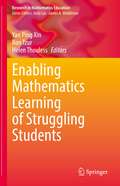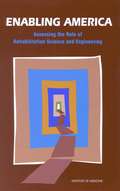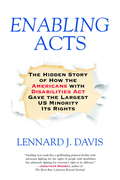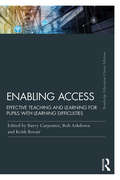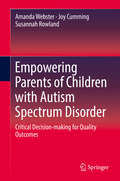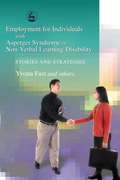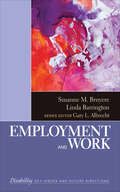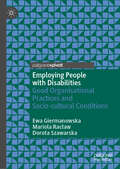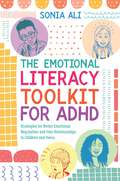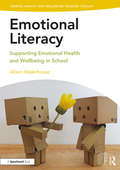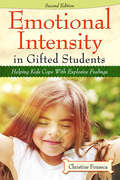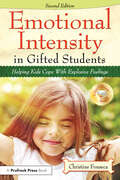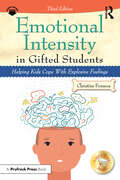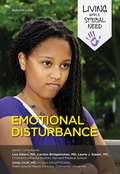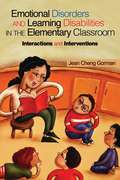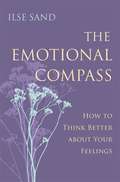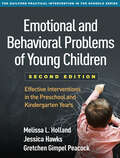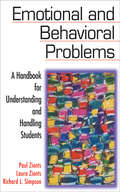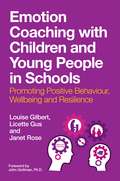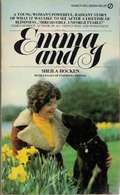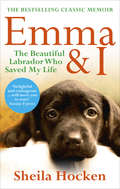- Table View
- List View
Enabling Romance: A Guide to Love, Sex, and Relationships For People With Disabilities
by Ken Kroll Erica KleinThe first comprehensive, practical guide to relationships for the physically challenged. Offers complete information on the social, romantic, and sexual requirements posed by a wide range of disabilities.
Enabling Mathematics Learning of Struggling Students (Research in Mathematics Education)
by Yan Ping Xin Ron Tzur Helen ThoulessThis book provides prospective and practicing teachers with research insights into the mathematical difficulties of students with learning disabilities and classroom practices that address these difficulties. This linkage between research and practice celebrates teachers as learners of their own students’ mathematical thinking, thus contributing an alternative view of mathematical progression in which students are taught conceptually. The research-based volume presents a unique collaboration among researchers in special education, psychology, and mathematics education from around the world. It reflects an ongoing work by members of the International Group for the Psychology of Mathematics Education (PME) and the North American Chapter of the PME Working Groups. The authors of chapters in this book, who have been collaborating extensively over the past 7 years, are from Australia, Canada, the United Kingdom, and the United States.
Enabling America: Assessing the Role of Rehabilitation Science and Engineering
by Edward N. Brandt Andrew M. PopeThe most recent high-profile advocate for Americans with disabilities, actor Christopher Reeve, has highlighted for the public the economic and social costs of disability and the importance of rehabilitation. Enabling America is a major analysis of the field of rehabilitation science and engineering. The book explains how to achieve recognition for this evolving field of study, how to set priorities, and how to improve the organization and administration of the numerous federal research programs in this area.The committee introduces the "enabling-disability process" model, which enhances the concepts of disability and rehabilitation, and reviews what is known and what research priorities are emerging in the areas of: Pathology and impairment, including differences between children and adults. Functional limitations--in a person's ability to eat or walk, for example. Disability as the interaction between a person's pathologies, impairments, and functional limitations and the surrounding physical and social environments. This landmark volume will be of special interest to anyone involved in rehabilitation science and engineering: federal policymakers, rehabilitation practitioners and administrators, researchers, and advocates for persons with disabilities.
Enabling Acts
by Lennard J. Davis<P>The first significant book on the history and impact of the ADA--the "eyes on the prize" moment for disability rights. <P>The Americans with Disabilities Act (ADA) is the widest-ranging and most comprehensive piece of civil rights legislation ever passed in the United States, and it has become the model for disability-based laws around the world. Yet the surprising story behind how the bill came to be is little known. <P>In this riveting account, acclaimed disability scholar Lennard J. Davis delivers the first behind-the-scenes and on-the-ground narrative of how a band of leftist Berkeley hippies managed to make an alliance with upper-crust, conservative Republicans to bring about a truly bipartisan bill. <P>Based on extensive interviews with all the major players involved including legislators and activists, Davis recreates the dramatic tension of a story that is anything but a dry account of bills and speeches. Rather, it's filled with one indefatigable character after another, culminating in explosive moments when the hidden army of the disability community stages scenes like the iconic "Capitol Crawl" or an event some describe as "deaf Selma," when students stormed Gallaudet University demanding a "Deaf President Now!" <P>From inside the offices of newly formed disability groups to secret breakfast meetings surreptitiously held outside the White House grounds, here we meet countless unsung characters, including political heavyweights and disability advocates on the front lines. "You want to fight?" an angered Ted Kennedy would shout in an upstairs room at the Capitol while negotiating the final details of the ADA. Congressman Tony Coelho, whose parents once thought him to be possessed by the devil because of his epilepsy, later became the bill's primary sponsor. There's Justin Dart, adorned in disability power buttons and his signature cowboy hat, who took to the road canvassing fifty states, and people like Patrisha Wright, also known as "The General," Arlene Myerson or "the brains," "architect" Bob Funk, and visionary Mary Lou Breslin, who left the hippie highlands of the West to pursue equal rights in the marble halls of DC. <P>Published for the twenty-fifth anniversary of the ADA, Enabling Acts promises to ignite readers in a discussion of disability rights by documenting this "eyes on the prize" moment for tens of millions of American citizens.
Enabling Access: Effective Teaching and Learning for Pupils with Learning Difficulties
by Barry Carpenter Rob Ashdown Keith BovairThis Routledge Classic Edition brings together widely experienced editors and contributors to show how access to a whole school curriculum can be provided for learners with moderate to profound and multiple learning difficulties. Along with a new appraisal of the contents from the editors, the contributors raise debates, illustrate effective teaching ideas and discuss strategies for providing a high-quality education for these pupils and a celebration of their achievements. The book also discusses the active involvement of family members and the learners themselves in these processes and considers issues surrounding empowerment of learners, professional development of the workforce and curriculum principles such as differentiation, personalisation, and engagement. Winner of the prestigious nasen/TES Academic Book Award in 1996, Enabling Access is an essential read for students and lecturers in higher education, and for teachers, support staff, and other professionals in all educational settings in the UK and abroad catering for these learners.
Empowering Parents of Children with Autism Spectrum Disorder
by Amanda Webster Joy Cumming Susannah RowlandThis book presents an international research-based framework that has empowered parents of children with autism spectrum disorder (ASD) to become critical decision makers to actively guide their child's learning and self-advocacy. Parents can use this framework to identify their child's vision and dreams, and to work with educators and service providers to establish specific learning goals and to implement effective interventions and programs that enable their child to achieve those goals and realise their vision for the future. The book begins by reviewing available research on evidence-based practice for children with ASD and outlining the Cycle of Learning decision-making framework for parents and professionals. Throughout the remainder of the book, case studies are presented to illustrate the ways in which different parents have successfully utilised this framework to develop effective plans for their child and to advocate for learning and education programs for both their child and other children with ASD in school and community settings. In addition, it highlights concrete examples of how parents have used the framework to empower their children with ASD to develop their self-awareness and self-determination, and to be able to self-advocate as they move through adolescence and into adult life.
Employment for Individuals with Asperger Syndrome or Non-Verbal Learning Disability: Stories and Strategies
by Yvona FastMost people with Non-Verbal Learning Disorder (NLD) or Asperger Syndrome (AS) are underemployed. This book sets out to change this. With practical and technical advice on everything from job hunting to interview techniques, from 'fitting in' in the workplace to whether or not to disclose a diagnosis, this book guides people with NLD or AS successfully through the employment mine field. There is also information for employers, agencies and careers counsellors on AS and NLD as 'invisible' disabilities, including an analysis of the typical strengths of somebody with NLD or AS, and how to use these positively in the workplace. Practical information and lists of career resources are supported by numerous case studies to inspire and advise. An essential resource for people with NLD or AS seeking or in employment and their existing or potential employers.
Employment and Work
by Susanne Marie Bruyère Linda BarringtonThis volume in The SAGE Reference Series on Disability explores issues facing people with disabilities in employment and the work environment. It is one of eight volumes in the cross-disciplinary and issues-based series, which incorporates links from varied fields making up Disability Studies as volumes examine topics central to the lives of individuals with disabilities and their families. With a balance of history, theory, research, and application, specialists set out the findings and implications of research and practice for others whose current or future work involves the care and/or study of those with disabilities, as well as for the disabled themselves. The presentational style (concise and engaging) emphasizes accessibility. Taken individually, each volume sets out the fundamentals of the topic it addresses, accompanied by compiled data and statistics, recommended further readings, a guide to organizations and associations, and other annotated resources, thus providing the ideal introductory platform and gateway for further study. Taken together, the series represents both a survey of major disability issues and a guide to new directions and trends and contemporary resources in the field as a whole.
Employing People with Disabilities: Good Organisational Practices and Socio-cultural Conditions
by Ewa Giermanowska Mariola Racław Dorota SzawarskaDeveloping better employment and management practices for a diverse workplace is quickly becoming a major concern amongst most modern organisations; however, a lack of research into good practices has a limiting effect. Dealing specifically with disabilities, this pioneering work is based on international research spanning several European countries to demonstrate best practice. Aiming to fill a gap in knowledge, the authors offer interdisciplinary insights into managing diversity in the workplace, taking into account various social and cultural contexts. Providing analysis and recommendations for adapting organisational practices to different workplace settings, this Palgrave Pivot is a vital read for scholars of HRM and diversity management, as well as policy-makers and practitioners.
The Emotional Literacy Toolkit for ADHD: Strategies for Better Emotional Regulation and Peer Relationships in Children and Teens
by Sonia AliChallenges with emotional regulation and rejection sensitivity can disproportionately affect children and teens with ADHD, impacting on their development at school and their relationship with their peers.Developed for children and young people who experience difficulties with emotional regulation, SEND specialist Sonia Ali, shares a mentoring Intervention programme to support a child or young person with this issue at school or at home. Covering concepts like the fight, flight or freeze response and the 'Window of Tolerance', managing anger outbursts and overwhelm or navigating conflict with peers, this easily digestible book will help educators and carers support children and teens to develop core emotional literacy skills in an enjoyable way!This accessible, step-by-step guide is packed with activities, including role-play situations, discussion-based statements, quizzes and more. The programme can be followed sequentially or 'dipped into' to support a child with a particular issue when relevant.
Emotional Literacy: Supporting Emotional Health and Wellbeing in School (Mental Health and Wellbeing Teacher Toolkit)
by Alison WaterhouseOne of the five books in the Mental Health and Wellbeing Toolkit for teachers and other professionals working with children, this practical resource focuses on the topic of ‘Emotional Literacy’ and how to support children and young people on a journey of self-discovery where they learn to recognise, understand, share and manage a range of emotions. Promoting a proactive rather than a reactive approach to dealing with the social and emotional aspects of learning and managing the world of today, Emotional Literacy addresses the increasing number of mental health issues arising among young people. Chapters span key topics including Recognising Emotions, Understanding Emotions, Self-Regulation and Empathy. This book offers: • Easy to follow, and flexible, lesson plans that can be adapted and personalised for use in lessons or smaller groups or 1:1 work. • Resources that are linked to the PSHE and Wellbeing curriculum for KS1, KS2 and KS3. • New research, ‘Circles for Learning’, where the introduction of baby observation into the classroom by a teacher is used to understand and develop self-awareness, skills for learning, relationships, neuroscience and awareness of others. • Sections on the development of key skills in communication, skills for learning, collaboration, empathy and self-confidence. • Learning links, learning objectives and reflection questions. Offering research-driven, practical strategies and lesson plans, Emotional Literacy is an essential resource book for educators and health professionals looking to have a positive impact on the mental health and wellbeing of the children in their care; both now and in the future.
Emotional Intensity in Gifted Students
by Christine FonsecaTeaching children how to manage their intense emotions is one of the most difficult aspects of parenting or educating gifted children. Emotional Intensity in Gifted Students: Helping Kids Cope With Explosive Feelings provides a much-needed resource for parents and educators for understanding of why gifted children are so extreme in their behavior and how to manage the highs and lows that accompany emotional intensity. Presented in an easy-to-read, conversational style, this revised and updated second edition contains additional chapters addressing temperament and personality development, as well as expanded role-plays and strategies designed to show parents and teachers how to interact and guide gifted children in a way that teaches them how to recognize, monitor, and adjust their behavior. Updated resources and worksheets make this practical resource a must-read for anyone wishing to make a positive and lasting impact on the lives of gifted children.
Emotional Intensity in Gifted Students: Helping Kids Cope With Explosive Feelings
by Christine FonsecaTeaching children how to manage their intense emotions is one of the most difficult aspects of parenting or educating gifted children. Emotional Intensity in Gifted Students: Helping Kids Cope With Explosive Feelings provides a much-needed resource for parents and educators for understanding of why gifted children are so extreme in their behavior and how to manage the highs and lows that accompany emotional intensity. Presented in an easy-to-read, conversational style, this revised and updated second edition contains additional chapters addressing temperament and personality development, as well as expanded role-plays and strategies designed to show parents and teachers how to interact and guide gifted children in a way that teaches them how to recognize, monitor, and adjust their behavior. Updated resources and worksheets make this practical resource a must-read for anyone wishing to make a positive and lasting impact on the lives of gifted children.
Emotional Intensity in Gifted Students: Helping Kids Cope With Explosive Feelings
by Christine FonsecaTeaching children how to manage their intense emotions is one of the most difficult aspects of parenting or educating gifted children. Emotional Intensity in Gifted Students is an indispensable resource for parents and educators seeking to understand why gifted children can be so extreme in their behavior and how to manage the highs and lows that accompany emotional intensity. Presented in an easy-to-read, conversational style, this revised and updated third edition pulls from contemporary research to depict changes in how we understand and support gifted children as well as an increased understanding of trauma, social-emotional learning, and empathy development. Chapters feature role-plays and strategies designed to show parents and teachers how to interact and guide gifted children in a way that teaches them how to recognize, monitor, and adjust their behavior. Also featuring updated resources, worksheets, and checklists, this practical new edition is a must-read for anyone wishing to make a positive and lasting impact on the lives of gifted children.
Emotional Intelligence of visually impaired
by Amruta PandaThis book has been an attempt to find out the relation which exist in terms of emotional intelligence, level of aspiration and educational achievement of different categories of visually impaired adolescent girls studying in various settings.
Emotional Disturbance
by Autumn LibalBeing a teenager is never easy. This phase of life is filled with changes, and new, unexpected challenges are always presenting themselves. For someone who has trouble controlling her emotions, these challenges can be especially hard to handle. As you read the story of Sheila, a teenager with an emotional disturbance, you will find out what it means to live with these extra challenges. You'll learn about some of the systems in place to help kids like Sheila, as well as some of the strengths and weaknesses of these systems. You'll discover that teenagers with emotional disturbance aren't so very different from you and your friends!
Emotional Disorders and Learning Disabilities in the Classroom: Interactions and Interventions
by Jean Cheng GormanThis unique book focuses on the interaction of learning disabilities and emotional disorders, fostering an understanding of how learning problems affect emotional well-being, and vice-versa. Jean Cheng Gorman provides research-based, classroom-tested practical interventions teachers can integrate into their daily routines, to help students become more purposeful and more effective. This book serves as a resource and a practical classroom guide for all elementary school teachers who are presented with the challenges of addressing the multiple needs - academic, emotional and social - of children with learning disabilities and emotional problems. Part I presents an overview of common learning disabilities and emotional problems. What disorders are teachers most likely to encounter? When should educators intervene, and when should they seek help from others? Part II offers specific classroom interactions and interventions, including insights on how: - Learning disorders are associated with emotional problems - Emotional problems can hide learning disabilities - Learning disorders can exacerbate emotional conditions - Emotional problems can intensify learning disabilities - Emotional health enhances learning . . . and each chapters includes tangible steps teachers can take in their classroom, as well as reproducibles that can be used as is, or as a starting point for materials development. The book ends with a rich and up-to-date list of additional resources for teachers and an annotated bibliography of children’s books and materials. Elementary teachers, administrators, and professional development directors can use this unique and comprehensive book as a solid foundation of knowledge and a practical resource for intervention.
The Emotional Compass: How to Think Better about Your Feelings
by Ilse Sand'Feelings are something we have, not something we are.' Revealing the complexity of emotions such as happiness, anger, fear, and jealousy, and how these are based on our perception of other people, Ilse Sand offers her professional wisdom on the psychology of feelings. Establishing that emotions are not always as appropriate as they first appear to be, the book encourages you to take a closer look at why you are feeling certain things, and how you can change how you feel. Especially written for highly sensitive people, guidance is included on how to identify the vulnerable feelings that often underlie our more volatile emotional states, and practical activities are suggested to help to embrace or reject sadness, delay impulsive actions, and allow yourself to be happy. Drawing on real-life examples throughout, the book offers you the means to improve your understanding of not only your own emotions and emotional actions, but those of others. The book will be immensely useful not only to people who feel things strongly, but to those who have trouble understanding or interpreting emotions and how to respond to the feelings they provoke.
Emotional and Behavioral Problems of Young Children, Second Edition: Effective Interventions in the Preschool and Kindergarten Years
by Gretchen Gimpel Peacock Jessica Malmberg Melissa L. HollandPresenting interventions that are practical, effective, and easy to implement in educational and clinical settings, this book addresses the most frequently encountered emotional and behavioral problems in 3- to 6-year-olds. Strategies for collaborating with parents are emphasized. Practitioners are taken step by step through assessing and treating conduct problems, anxiety and other internalizing problems, toileting difficulties, picky eating and related concerns, and sleep problems. User-friendly features include 36 reproducible parent handouts, assessment forms, and other clinical tools; the print book has a large-size format with lay-flat binding for easy photocopying. Purchasers get access to a Web page where they can download and print the reproducible materials. This book is in The Guilford Practical Intervention in the Schools Series. New to This Edition *Reflects over a decade of research advances, plus new assessments and interventions. *Updated for DSM-5. *Chapter on intervention within a multi-tiered system of support (MTSS). *Chapter on referral procedures for complex problems. *Mindfulness techniques for both parents and children. *Cutting-edge ways to use acceptance and commitment therapy principles and motivational interviewing with parents. *23 new or revised reproducible tools.
Emotional and Behavioral Problems: A Handbook for Understanding and Handling Students
by Richard L. Simpson Paul Zionts Laura T. ZiontsThe authors take a complex, under-discussed topic and give teachers and administrators useful, basic guidelines they can put to use quickly in understanding, identifying, and helping this special group of students.
Emotion Coaching with Children and Young People in Schools: Promoting Positive Behavior, Wellbeing and Resilience
by Louise Gilbert Licette Gus Janet RoseEmotion Coaching (EC) is a universal communication strategy which supports children and young people to self-regulate and manage their stress responses. Originally noticed as an effective way parents communicated with their children around challenging behaviours, Emotion Coaching has been shown to be highly successful in educational settings too. This is why the authors pioneered the research and application of Emotion Coaching into UK (primary and secondary) schools and community settings. The book includes straightforward descriptions and practical tips, with signposting to resources, case studies and vignettes to illustrate its practical application in educational settings. It supports adults to promote empathetic responses to challenging behaviours and situations, helping children and young people to understand their emotions and learn to manage them and their behavior in the longer-term.
Emma's Story
by Sheila HockenFrom the Book Jacket: SPRING DIGGING It was lovely helping Paddy in the garden. Digging up weeds -I gave her a helping paw there watching her put things in. After lunch Paddy said she'd put in everything she wanted to, and was now going to do some baking in the kitchen, but as it was quite sunny I could stop out in the garden. I went round again sniffing all the things she'd buried. Perhaps she'd left them there and wanted to get them out later, like I did sometimes with bones? If I did that for her now it would save her such a lot of time. So I went round and dug them all up. It took me ages. There were about a hundred. Won't she be pleased, I thought, when she knows I found every one and brought them all back for her? It wasn't long before she opened the door. 'Emma, come on in, it's teatime. ' Then she spotted the bulbs. I sat there looking pleased with myself. But she suddenly started laughing. 'Oh Emma... no. What have you done?' 'My name is Emma and I'm a chocolate-coloured labrador. Most other labradors are black or yellow, but not only am I a very special colour, I used to be a very special dog. I used to be a guide dog--and that isn't something any dog can do. So I'm going to tell you how to be a guide dog, right from the beginning, from when I was a puppy.' EMMA & I and EMMA V.I.P. have made Emma a very famous guide dog indeed. Now Sheila Hocken tells the full story of Emma's training from Emma's point of view This really is Emma's story, a book as lovable and lively as Emma herself.
Emma V.I.P
by Sheila HockenSequel to Emma and I. Sheila talks about her life after being able to see again, about learning and relearning to read print, about seeing snow for the first time, and about the other things, including the pitfalls and joys of regaining vision. She also talks about the birth of her daughter Kerensa, and of three additions to the family, of her dreams of owning a cattery and kennels, and of Don's and her fears that Kerensa may be blind. The story is interwoven with stories of Emma, in retirement, of the publication of Emma and I, and of the new pups in the family, Bracken and Buttons.
Emma and I
by Sheila HockenA touching and unique story of love and courage. This is Sheila Hocken's own story. A story of a young blind girl who sets out to fight for the right to live fully and to see again. Sheila's account of the events and people that transformed her life is moving and inspiring. Sheila introduces Emma, her beautiful chocolate-brown labrador, whose devotion and intelligence as a guide dog are inspiring. We also meet Don, who brings romance into Sheila's life - through a radio program! And we meet Mr Shearing, the skilled surgeon who performs the miracle which gives Sheila a whole new world.
Emma and I
by Sheila HockenAs a girl, Sheila never let her gradual descent into blindness prevent her from trying to do everything a sighted person could do. Then at 17, unable to see to find her way around the house she grew up in, she found herself dreading her future in an 'ever darkening vacuum'.But then the remarkable Emma enters her life, and Sheila begins a journey that brings her the independence, love and happiness she never dreamed possible.Emma and I is the moving and inspirational story of the unique bond between Sheila and her dog, and shows that, sometimes, miracles do happen.

